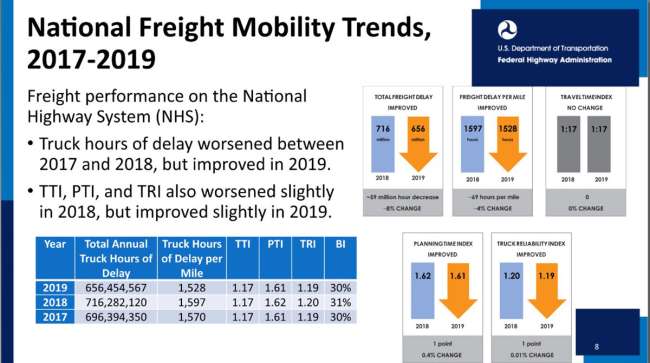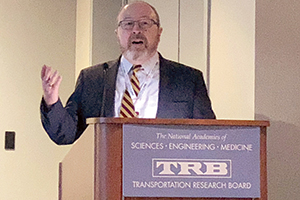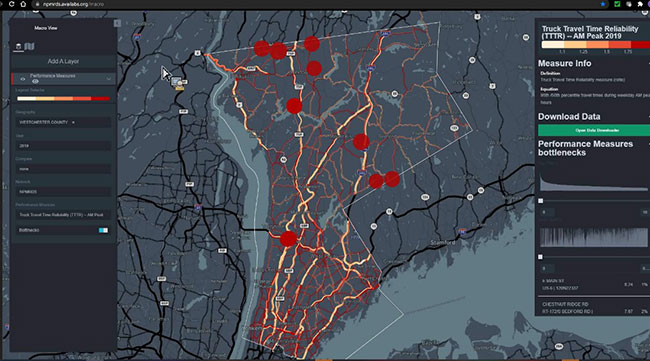Staff Reporter
Teleworking Travel Habits May Offer Insight on Freight Mobility, Expert Says

[Stay on top of transportation news: Get TTNews in your inbox.]
Data on the drastic changes in commuting patterns that resulted from the COVID-19 pandemic likely will present useful insight on impacts to freight movement, according to a Federal Highway Administration expert.
Jeff Purdy, a transportation specialist in FHWA’s Office of Freight Management and Operations, said delays declined in 2020 as many people worked from home. Purdy delivered a presentation at a webinar hosted by FHWA on June 16. The event was part of FHWA’s Talking Freight seminar series.
“Nationwide, on the interstate system, the delay between 2019 and 2020 went down 20%,” Purdy said. “We see a sharp decline in delay. I think there might be some interesting insights that come out of the data once we complete our analysis of 2020 data in terms of if you have situations where you have a high level of people teleworking, the impact that can have on the transportation system in terms of the reduction in delay.”

FHWA's Purdy, shown at an industry conference in 2020, says delays on the interstate system declined by 20% from 2019 to 2020. (Eleanor Lamb/Transport Topics)
FHWA maintains the National Performance Management Research Data Set (NPMRDS), a database of speed and travel time data. Agencies can use the data to monitor mobility conditions across the National Highway System.
The NPMRDS also contains aggregated truck travel time data. Purdy explained FHWA has developed a series of freight mobility indicators, such as congestion cost and indexes for planning time and truck reliability. The data platform also can track performance at different intermodal hubs, such as cargo airports, rail facilities and ports.
According to FHWA data regarding freight performance on the National Highway System, truck hours of delay worsened between 2017 and 2018, but improved in 2019. Annual truck hours of delay totaled 696 million in 2017 and 716 million in 2018. By 2019, total annual truck hours of delay had decreased to 656 million.
“We hope that this will be a valuable tool for states and [metropolitan planning organizations] to use,” Purdy said. “Being able to look at things at a larger scale is really what our attempt was.”
In partnership with the State University of New York’s University at Albany Visualization and Informatics Lab, the New York State Department of Transportation developed a user-friendly NPMRDS toolkit. Alan Warde, acting head of the Statewide Policy Development Section at NYSDOT, said the resource offers a “macro” overview of county geographies with several metrics, such as delay data and average daily traffic.

Graphic that shows truck travel time reliability during the morning rush hour in Westchester County, N.Y., via a tool created by State University of New York at Albany and the New York State Department of Transportation. (Federal Highway Administration)
Warde explained the tool is somewhat unique in that it provides information on the quality and number of the sampled data that underlies the calculations and metrics of individual highway segments.
“We have the capability of going in and setting a threshold for the percentage of time periods reported,” Warde said. “We have a measure of the data quality that’s behind each one of these areas. This is a tool that we’re increasingly using to make sure the bottlenecks that we identify have a robust level of data informing them.”
The Texas A&M Transportation Institute, in partnership with the Texas Department of Transportation, built the Truck Congestion Analysis Tool, which is a planning resource for analyzing and monitoring truck mobility. The tool allows users to view specific roadway details by customizing corridors, which involves selecting starting and ending points on route segments.
L.D. White, a research specialist with the Texas A&M Transportation Institute, said possible future enhancements to the tool may include crash and safety information as well as truck origin and destination patterns.
In terms of private sector communication, Purdy said many large trucking companies already have sophisticated systems in place for routing their trucks, but noted information sharing between these organizations and the public sector is valuable nonetheless.
“At [FHWA], we try to partner with the trucking industry as much as possible in terms of sharing information and data back and forth,” Purdy said. “I think that dialogue between the public and private sector is very important.”
Want more news? Listen to today's daily briefing below or go here for more info:




